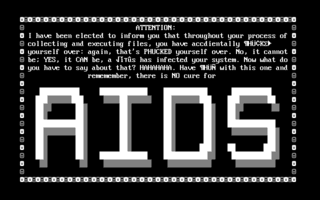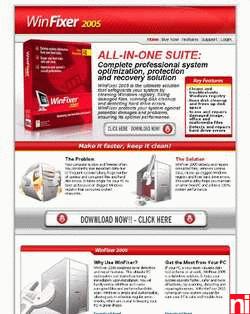Related Research Articles

Antivirus software, also known as anti-malware, is a computer program used to prevent, detect, and remove malware.
Abraxas, also known as Abraxas5, discovered in April 1993, is an encrypted, overwriting, file infecting computer virus which infects .COM and .EXE files, although it does not infect command.com. It does not become memory resident. Each time an infected file is executed, Abraxas infects the copy of dosshell.com located in the C:\DOS directory, as well as one EXE file in the current directory. Due to a bug in the virus, only the first EXE file in any directory is infected.

AIDS is a DOS computer virus which overwrites COM files.
Norton AntiVirus is an anti-virus or anti-malware software product founded by Peter Norton, developed and distributed by Symantec since 1990 as part of its Norton family of computer security products. It uses signatures and heuristics to identify viruses. Other features included in it are e-mail spam filtering and phishing protection.
ABC, discovered in October 1992, is a memory-resident, file-infecting computer virus which infects EXE files and may alter both COM and EXE files. ABC activates on the 13th day of every month.

WinFixer was a family of scareware rogue security programs developed by Winsoftware which claimed to repair computer system problems on Microsoft Windows computers if a user purchased the full version of the software. The software was mainly installed without the user's consent. McAfee claimed that "the primary function of the free version appears to be to alarm the user into paying for registration, at least partially based on false or erroneous detections." The program prompted the user to purchase a paid copy of the program.
Jerusalem is a logic bomb DOS virus first detected at Hebrew University of Jerusalem, in October 1987. On infection, the Jerusalem virus becomes memory resident, and then infects every executable file run, except for COMMAND.COM. COM files grow by 1,813 bytes when infected by Jerusalem and are not re-infected. Executable files grow by 1,808 to 1,823 bytes each time they are infected, and are then re-infected each time the files are loaded until they are too large to load into memory. Some .EXE files are infected but do not grow because several overlays follow the genuine .EXE file in the same file. Sometimes .EXE files are incorrectly infected, causing the program to fail to run as soon as it is executed.
Bifrost is a backdoor trojan horse family of more than 10 variants which can infect Windows 95 through Windows 10. Bifrost uses the typical server, server builder, and client backdoor program configuration to allow a remote attacker, who uses the client, to execute arbitrary code on the compromised machine.
Scott's Valley [sic] is a computer virus, a member of the Slow virus family and distantly related to the Jerusalem virus family. It was discovered in September 1990 in Scotts Valley, California.
Alabama is a computer virus, discovered in October 1989 on the campus of the Hebrew University of Jerusalem.
Ontario is a family of computer viruses, named after its point of isolation, the Canadian province of Ontario. This family of computer virus consists of Ontario.1024, Ontario.512 and Ontario.2048. The first variant Ontario.512 was discovered in July 1990. Because Ontario.1024 was also discovered in Ontario, it is likely that both viruses originate from within the province. By the Ontario.2048 variant, the author had adopted "Ontario" as the family's name and even included the name "Ontario-3" in the virus code.
CTX is a computer virus created in Spain in 1999. CTX was initially discovered as part of the Cholera worm, with which the author intentionally infected with CTX. Although the Cholera worm had the capability to send itself via email, the CTX worm quickly surpassed it in prevalence. Cholera is now considered obsolete, while CTX remains in the field, albeit with only rare discoveries.
The Vundo Trojan is either a Trojan horse or a computer worm that is known to cause popups and advertising for rogue antispyware programs, and sporadically other misbehavior including performance degradation and denial of service with some websites including Google and Facebook. It also is used to deliver other malware to its host computers. Later versions include rootkits and ransomware.
RavMonE, also known as RJump, is a Trojan that opens a backdoor on computers running Microsoft Windows. Once a computer is infected, the virus allows unauthorized users to gain access to the computer's contents. This poses a security risk for the infected machine's user, as the attacker can steal personal information, and use the computer as an access point into an internal network.

The Storm Worm is a phishing backdoor Trojan horse that affects computers using Microsoft operating systems, discovered on January 17, 2007. The worm is also known as:

A computer virus is a type of malware that, when executed, replicates itself by modifying other computer programs and inserting its own code into those programs. If this replication succeeds, the affected areas are then said to be "infected" with a computer virus, a metaphor derived from biological viruses.

Conficker, also known as Downup, Downadup and Kido, is a computer worm targeting the Microsoft Windows operating system that was first detected in November 2008. It uses flaws in Windows OS software and dictionary attacks on administrator passwords to propagate while forming a botnet, and has been unusually difficult to counter because of its combined use of many advanced malware techniques. The Conficker worm infected millions of computers including government, business and home computers in over 190 countries, making it the largest known computer worm infection since the 2003 SQL Slammer worm.
The Fun.Exe virus is of the w32.Assarm family of computer viruses. According to Symantec it registers itself as a Windows system process then periodically sends mail with spreading attachments as a response to any unopened emails in Outlook Express. This virus first appeared in early 2008 and is now recognized by most anti virus programs.
MS Antivirus is a scareware rogue anti-virus which purports to remove virus infections found on a computer running Microsoft Windows. It attempts to scam the user into purchasing a "full version" of the software. The company and the individuals behind Bakasoftware operated under other different 'company' names, including Innovagest2000, Innovative Marketing Ukraine, Pandora Software, LocusSoftware, etc.
Sality is the classification for a family of malicious software (malware), which infects Microsoft Windows systems files. Sality was first discovered in 2003 and has advanced to become a dynamic, enduring and full-featured form of malicious code. Systems infected with Sality may communicate over a peer-to-peer (P2P) network to form a botnet to relay spam, proxying of communications, exfiltrating sensitive data, compromising web servers and/or coordinating distributed computing tasks to process intensive tasks. Since 2010, certain variants of Sality have also incorporated rootkit functions as part of an ongoing evolution of the malware family. Because of its continued development and capabilities, Sality is considered one of the most complex and formidable forms of malware to date.
References
- ↑ F-Secure Computer Virus Information Pages: 5lo
- ↑ "5Lo". Symantec. Archived from the original on June 7, 2011. Retrieved 10 February 2013.